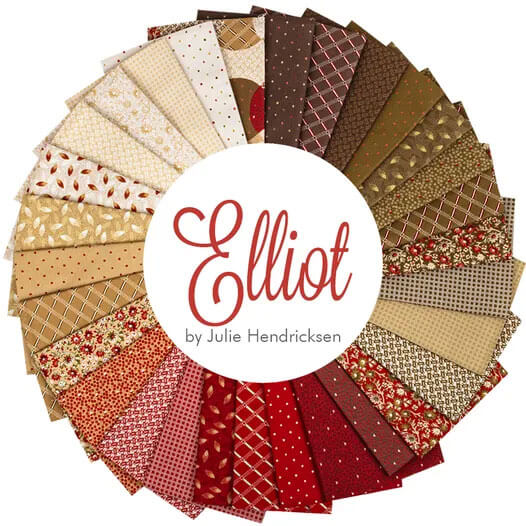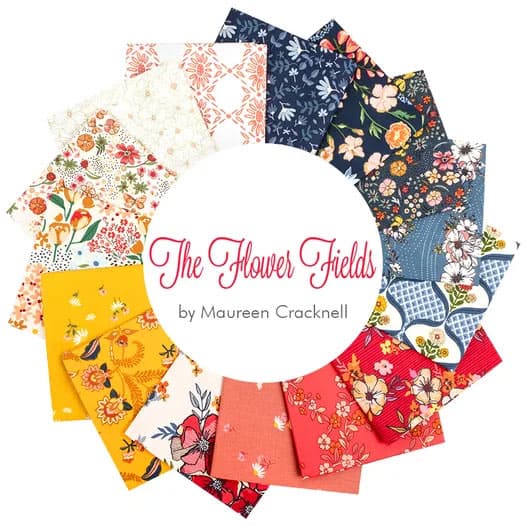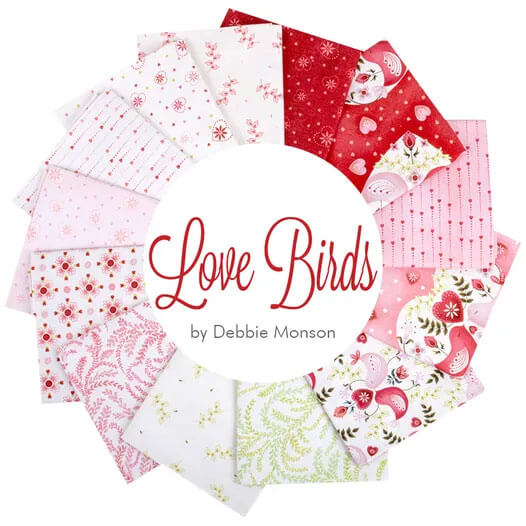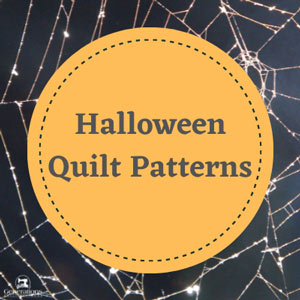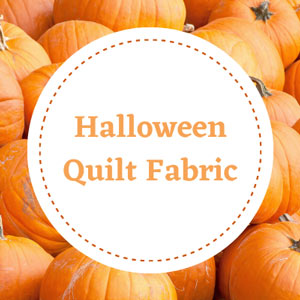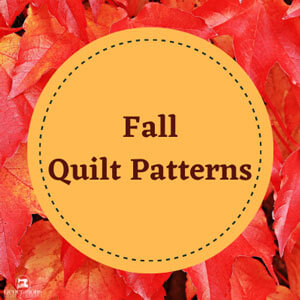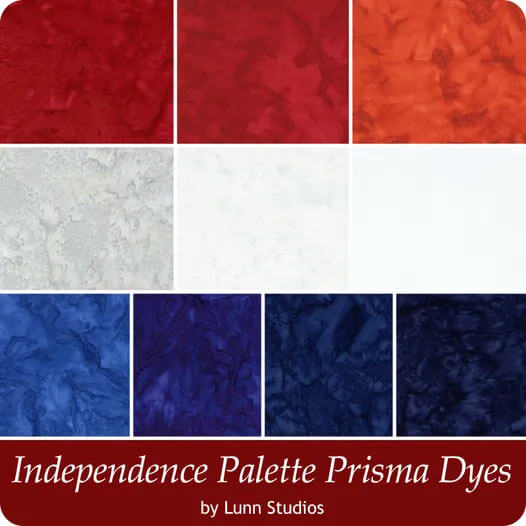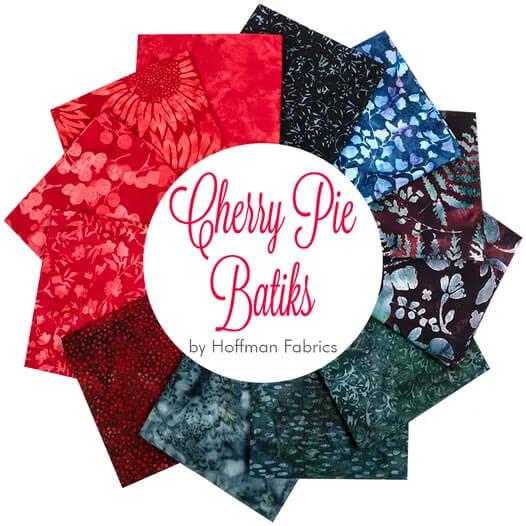- Home
- Free Quilt Block Patterns
- Priscillas Dream Quilt Block
Stack, Dream, Quilt: Fly High with the Priscilla's Dream Block:
8", 10", 12", and 16" finished blocks
This post contains affiliate links, for which I receive compensation.
Get ready to dream up your next stunning quilt with the Priscilla's Dream block.
With its stacked trios of Flying Geese, it looks like there's a lot of picky piecing and trimming to do.
But looks can be deceiving.
We'll use paper piecing to make quick work of those Geese#8212;accurately and without sacrificing any points. ;)
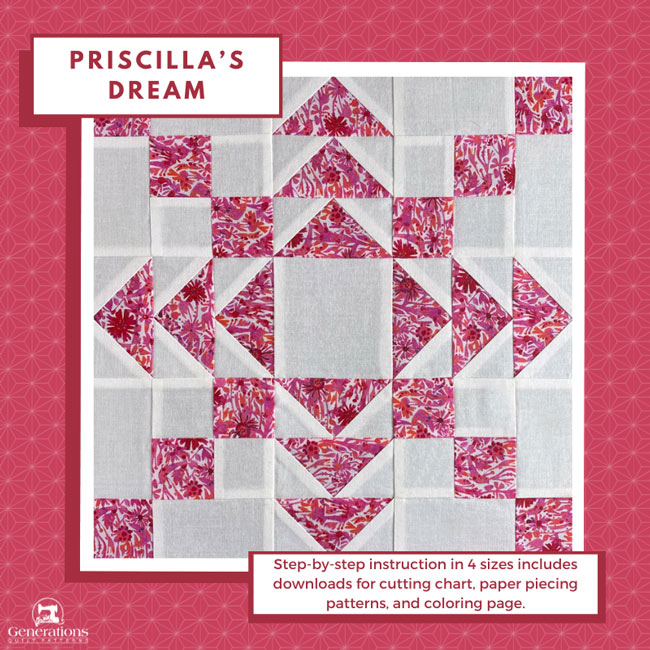
As always, beginner-friendly, illustrated instructions are the backbone of the tutorial. There's more free goodies available for you to download to help you. They are:
- A cutting chart in four sizes with downloads of the chart and block design
- Quilting taking a back seat to your hectic schedule? Don't stress, Pin or bookmark this handy how-to, so you can pick up the pieces and stitch together some quilting bliss later!
Cut. Sew. Press. Turn your fabric into MAGIC!
General Instructions
Several abbreviations are used on this page. They are:
- SA - seam allowance
- RST - right sides together
- HST - half square triangles
- QST - quarter square triangles
- FG - Flying Geese
A 1/4" SA is used in this tutorial.
Highlighted in yellow, pressing instructions are easy to spot.
To press, first press the patches in the closed position as they came off your sewing machine. This sets the seam, melding the fibers of the threads into the fibers of the fabric.
Then press the SA to the dark unless otherwise noted.
Starching your fabrics first just makes quilting easier and more accurate. Try a 50/50 solution of StaFlo Liquid Starch concentrate to water for more accurate cutting and piecing.
Download and print paper piecing pattern
To download the pattern, use the most current version of Adobe.
For accurate results, on Adobe's Print Menu page, under 'Page Size and Handling' set 'Custom Scale' to 100%. Then print.
Click here to see what it looks like on the Print Menu page.
Find your finished block size from the chart below. Print the corresponding number of pages for a total of 4 Flying Geese Trio units.
Download and Print | ||||
|---|---|---|---|---|
| Finished Block Size | # of copies to print | Finished Size | ||
| 8" | 1 | 2"x3" | ||
| 10" | 2 | 2½"x3¾" | ||
| 12" | 2 | 3"x4½" | ||
| 6" | 2 | 4" x 6" | ||
After printing, use the 1" square graphic on the printed page(s) to double check that your patterns printed at the correct size.
Then cut out the required number of patterns from your copies. A rough cut is good enough—an 1/8"-1/4"-ish away from the outside dashed rectangle.

Not sure which paper to use?
Take a look at my review of several of the most popular brands available to us quilters on the market.
You want a super-easy paper to tear away—less stress on the stitches.
The newest quilt fabrics to tickle your fancy...
Click the images below to see the full collection. We share any commercial and/or free patterns that showcase them, too. (For inspiration, of course!)
Step 1: Cutting patches
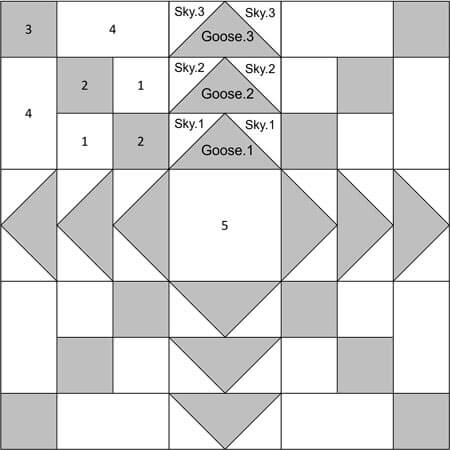 Priscilla's Dream quilt block
Priscilla's Dream quilt blockSample Block Size: 12" finished / 12½" unfinished
Grid: 8x8
Attribution: Detroit News/Public Service Bureau Home Newspaper
Brackman ID: #2082
Design Type: Uneven 9-patch, small center | Paper Piecing
The most important thing to remember is to choose fabrics with enough contrast so that the points don't disappear on you.
Imagine if you'd chosen a white background and a red with white polka dots for the A fabric. If a white polka dot landed at the point of a Goose, you won't see it.
Your piecing efforts would have been for naught.
Label all your patches, you use their numbers throughout this tutorial.
To print a copy of the block design and cutting chart to use at your cutting table, click here.
 | Cutting Chart for a~ Paper & Traditional Piecing ~ | ||||||
|---|---|---|---|---|---|---|---|
| Patch | Fabric | Qty | Finished Block Size | Sub Cut | |||
| 8'' | 10'' | 12'' | 16'' | ||||
| 1 | Bac | 1 | 1½'' x 13'' | 1¾'' x 15'' | 2'' x 17'' | 2½'' x 21'' | --- |
| 2 | A | 1 | 1½'' x 13'' | 1¾'' x 15'' | 2'' x 17'' | 2½'' x 21'' | --- |
| 3 | A | 4 | 1½'' x 1½'' | 1¾'' x 1¾'' | 2'' x 2'' | 2½'' x 2½'' | --- |
| 4 | Bac | 8 | 1½'' x 2½'' | 1¾'' x 3'' | 2'' x 3½'' | 2½'' x 4½'' | --- |
| 5 | Bac | 1 | 2½'' x 2½'' | 3'' x 3'' | 3½'' x 3½'' | 4½'' x 4½'' | --- |
| Goose.1-3 | A | 3 | 3⅝'' x 3⅝'' | 4⅛'' x 4⅛'' | 4⅝'' x 4⅝'' | 5⅝'' x 5⅝'' | |
| Sky.1-3 | Bac | 6 | 2⅜'' x 2⅜'' | 2⅝'' x 2⅝'' | 2⅞'' x 2⅞'' | 3⅜'' x 3⅜'' | |
| Unfinished Block Size | 8½'' | 10½'' | 12½'' | 16½'' | |||
| Grid Size | 1'' | 1¼'' | 1½'' | 2'' | |||
Step 2: Assemble the units for your Priscilla's Dream block
:We'll start with the paper piecing. Use the following instructions to set up your sewing machine for the technique.
General Sewing Machine Setup for Paperpiecing
- Reduce your stitch length to 16–20 stitches per inch (1.3-1.6 mm). This perforates the paper and stabilizes the seam when you remove the pattern. [Learn more about stitch length here.]
- Reduce your machine's speed or just plain slow down. Sew only as fast as you can stay on the stitching lines.
- Install an open toe appliqué foot (sometimes called an 'embroidery' or 'satin stitch' foot) if you have one (it's easier to see where you're stitching with one installed).
- Use a larger needle (90/14) if you have problems removing the pattern.
- If your machine has a needle stop up, use it. The stitching goes faster when you don't have to lift the presser foot with every seam.
- As you stitch each seam, start and stop a generous 1/4” before and after the solid stitching lines. ALWAYS. Future lines of stitching secure the ends.
After adding each patch, press the unit as it was sewn to set the seam and then open. The SA is automatically pressed towards the last patch added.
Before adding the next patch, take a look to make sure the one you just added covers the space plus seam allowance that it is supposed to.
Steam is optional and usually curls the pattern.
If that bothers you, don't use steam. Sometimes I do. Sometimes I don't.
It truly depends on my mood.
Remember, as you follow this paper piecing tutorial, the printed and the fabric sides of this block are mirror-images of each other.
At last!
Let's sew!
Flying Geese Trio
Make 4
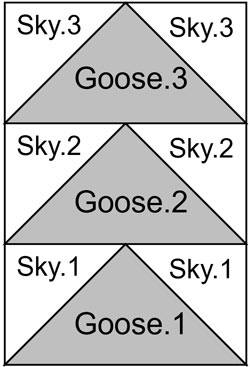 Flying Geese Trio unit
Flying Geese Trio unitWe could have made these Flying Geese individually using traditional techniques. I don't know about you, as a cut-it-bigger and trim-it-to-perfection kinda gal, that means I'm trimming four sides of three Geese for every unit. That's 12 trims.
Paper pieced 'trios of geese' mean there's only 4 trims per unit that count. Add to that the improved accuracy because the seam line is marked.
This is about as foolproof a method as I've found to make FGs. Give it a try and see if you don't agree!
Let's get started.
Use a dot of Elmer's Washable Glue Stick to hold FG1 in place on the unprinted side of the pattern. Dashed guidelines help you position it quickly and accurately the first time.
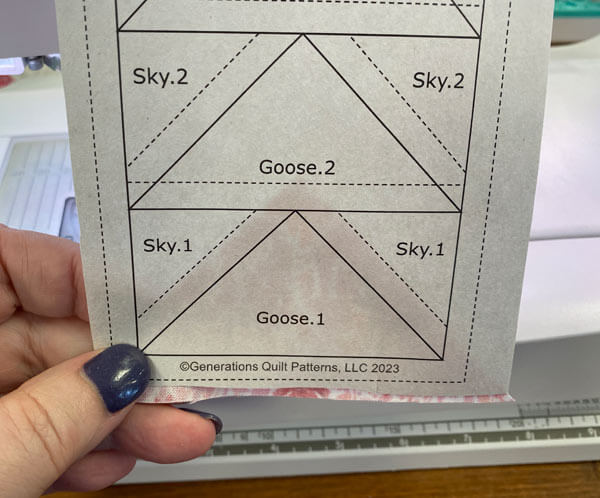 Your patch DOES hang below the bottom dashed line surrounding the block ON PURPOSE. When we trim, we want something TO trim.
Your patch DOES hang below the bottom dashed line surrounding the block ON PURPOSE. When we trim, we want something TO trim.With RST, position the long bias edge of a Sky.1 with one side of Goose.1. The bottom will be even with each other.
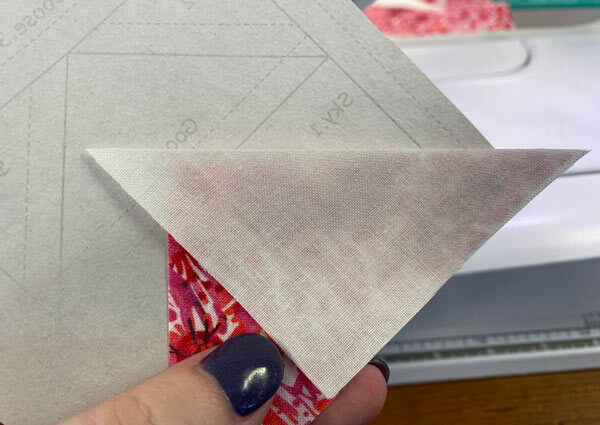
Start your stitching outside the dashed lines, sew on the solid line and then a generous 1/4" past the end of the solid line. (red arrows)
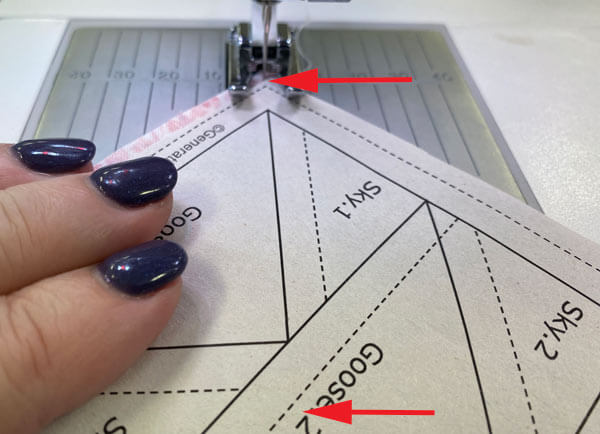
Press.
Repeat for the other Sky.1. This time your stitching will start in the middle of the paper pattern. Again, sew starting and ending a generous 1/4" before and after the solid line separting Goose.1 and Sky.1.
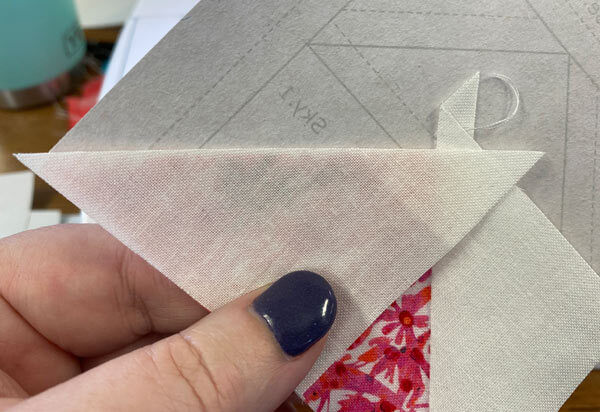
Press.
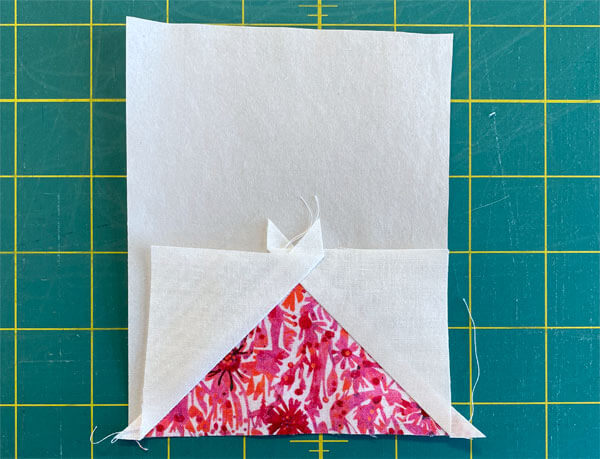 This little guy needs a trim!
This little guy needs a trim!We trim now to give us an accurate 1/4" SA which also shows us exactly where to postion Goose.2.
At your cutting mat, pull the pattern away from your stitches. The paper may rip a bit. This is normal.
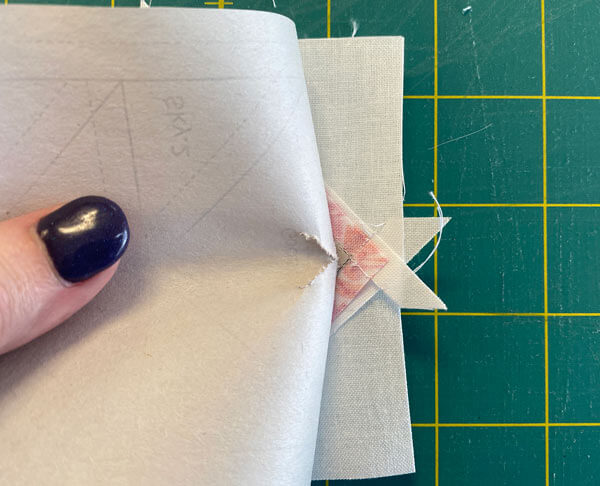
Line up the edge of your ruler with the solid line between the Sky.1s and Goose.2.
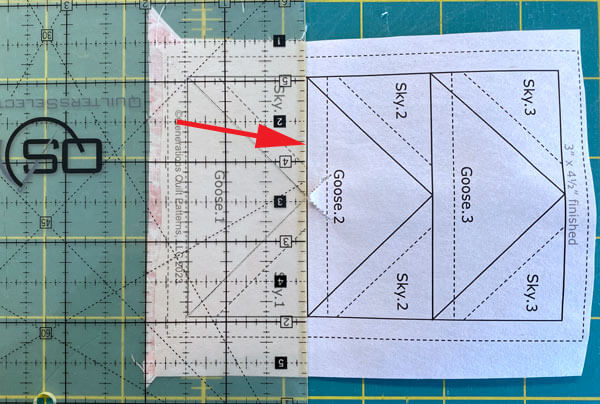
Fold the paper pattern back on itself and position the 1/4" mark on your ruler with the folded edge.
Trim away the excess fabric.
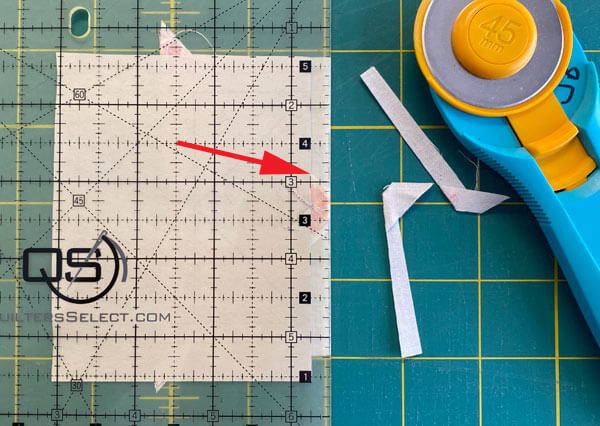
Use this perfectly trimmed edge to position the wide side of Goose.2, RST with the first FG.
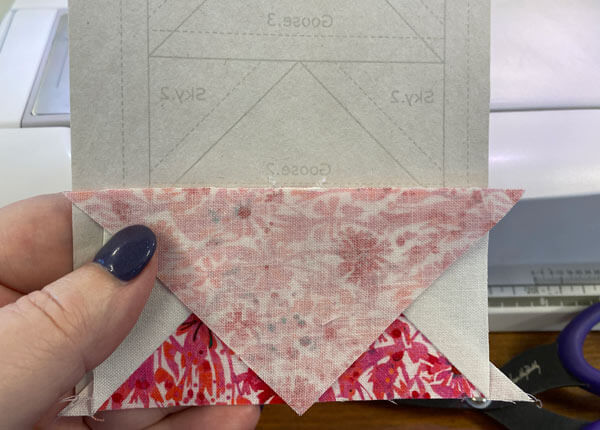
This seam runs from one to the other edge of the unit. That means—just like it does in traditional piecing—that you can chain piece this seam.
Who knew? Chain stitching in paper piecing!
At your cutting mat, trim both sides of Goose.2 just like you did the seam between the Geese, i.e., fold back on the solid line between each Sky.2 and Goose.2, position the ruler's 14" mark with the folded edge and trim away the excess.
Add the first Sky.2 triangle to one of the trimmed edges. RST, of course.
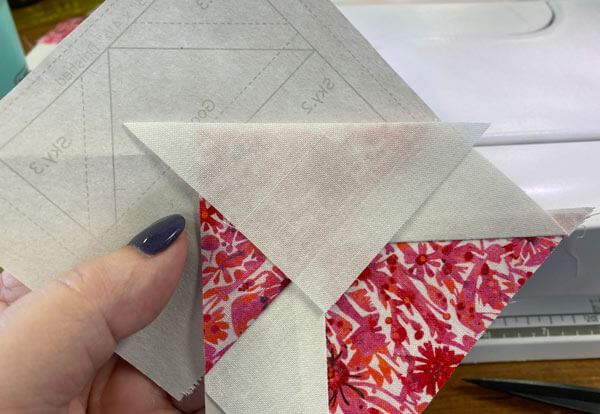 Adding our first Sky.2 triangle
Adding our first Sky.2 triangleAdd the second Sky.2.
Fold the paper pattern back on itself.
Repeat the whole trimming process that we used for the Goose.1 and Sky.1 patches.
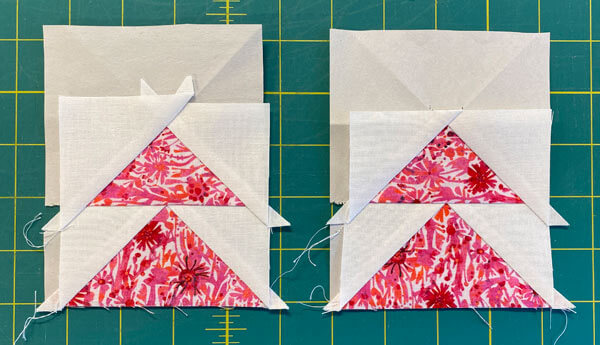 Before trimming (left) and after (right)
Before trimming (left) and after (right)Add the third Goose triangle and trim its edges to the perfect 1/4".
We've got more chain piecing ahead of us for the Sky.3s as both seams run from edge to edge. What's not to love?
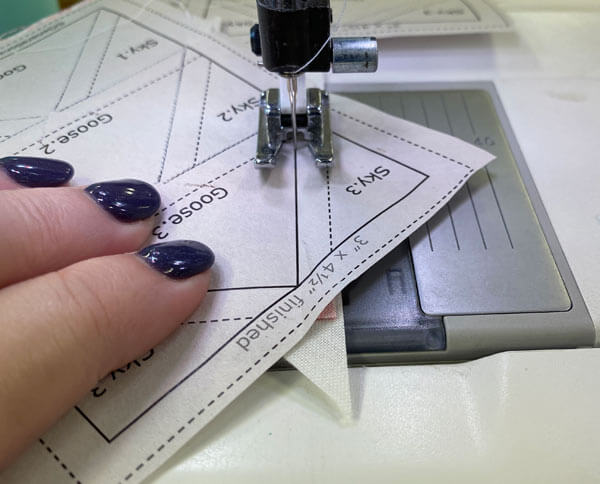 Adding the first Sky.3 triangle
Adding the first Sky.3 triangleGive your FG Trio a final press.
Looks like our unit is in delightful disarray on the left, eh? After trimming we've got perfection (middle). Our points are nice and pointy, not cut off. The seams are exactly where they need to be.
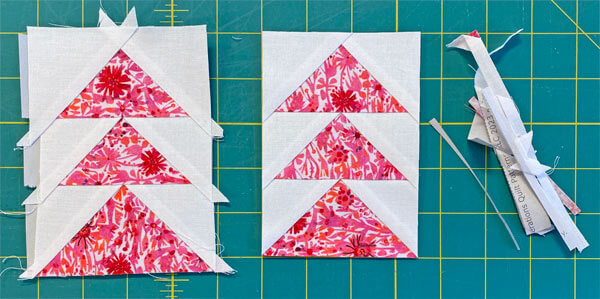
And all it cost us was a bit of fabric (right) and the patience to sew on a line.
Let's get the trimming done.
At our trusty cutting mat, line up the 1/4" line on the ruler with the solid line surrounding the block (all red arrows below) and trim away the excess (1st). Turn the unit a quarter turn and trim again (2nd). Continue for each side of each FG (3rd and 4th).
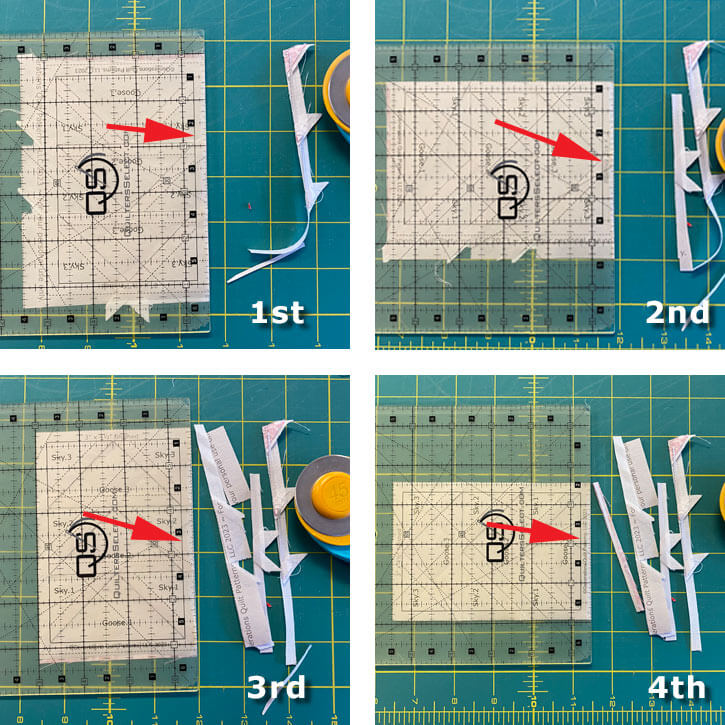
Why not line up the edge of the ruler with the dashed line?
Quite simply, it's harder to see and trim accurately. Try it and judge for yourself. What works best in quilting is what works best for YOU!
After you've stitched and trimmed all your FG, remove the paper pattern.
Because we precut patches according to the cutting chart, all the edges are on the straight of grain—just like any Flying Geese you'd traditionally piece.

The paper piecing is complete. From this point forward, return your stitch length to the one you regularly use for piecing and install your favorite 1/4" presser foot.
Corners
Make 4
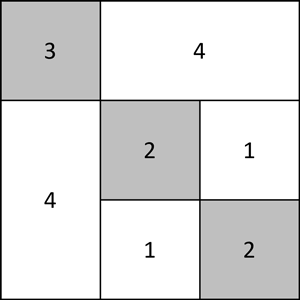 Corner unit
Corner unitWith RST, sew the long #1 and #2 strips together.
Press with the SA to the darker #2.
At the cutting mat, line up a straight line on your ruler with the seam line (red arrow), Trim away just a smidge to create a straight edge to start your subcutting from.
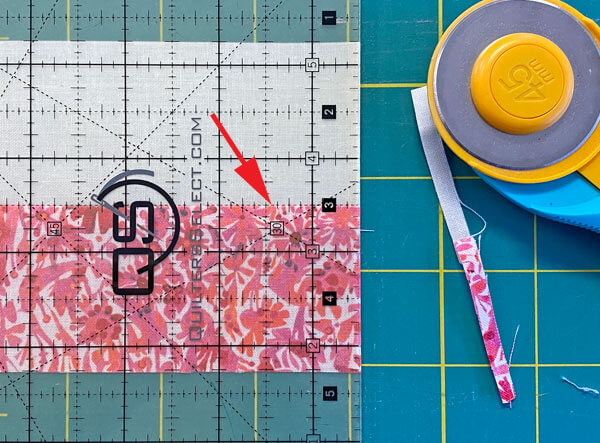
Find the Subcut Width that corresponds to the finished block size you're working on. For our 12" finished block the subcut is 2" wide.
Corner Unit Measuresments | ||||
|---|---|---|---|---|
| Finished Block Size | Stripset Width After Stitching | SubCut Width | Edge-to-edge | |
| 4-Patch | Corners | |||
| 8" | 2½" | 1½" | 2½" x 2½" | 3½" x 3½" |
| 10" | 3" | 1¾" | 3" x 3" | 4¼" x 4¼" |
| 12" | 3½" | 2" | 3½" x 3½" | 5" x 5" |
| 16" | 4½" | 2½" | 4½" x 4½" | 6½" x 6½" |
Subcut 8 units from your strip set.
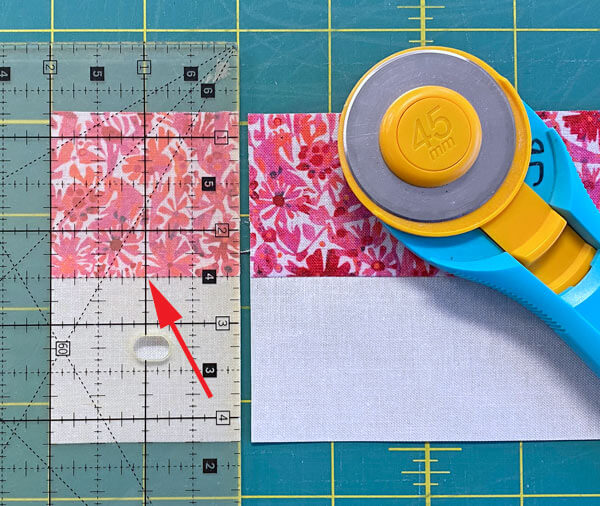
Arrange the patches into 4-patches, alternating the #1s and #2s.
Sew the pairs together. Their seams nest to make matching the seams in the center easy.
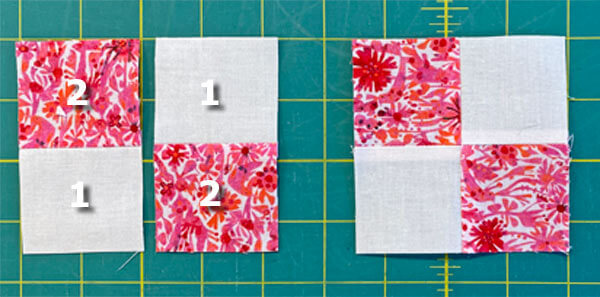
Use the chart again, to double-check the size of your 4-patches. (For our sample, these 4-patches should measure 3-1/2" square...and they do!)
With RST, sew a #3 to a #4. Press the SA to the darker #3.
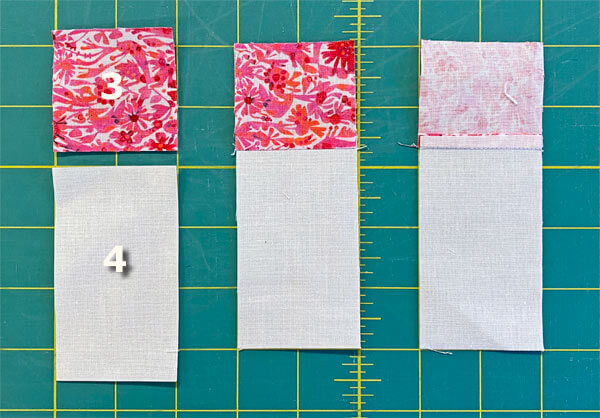
Arrange your patches as shown below (left).
With RST, stitch a #4 to a 4-patch (center). This SA is pressed toward the 4-patch.
Finally, stitch the #3/#4 to the #1/#2/#4.
This SA is pressed toward the four patch. (right)
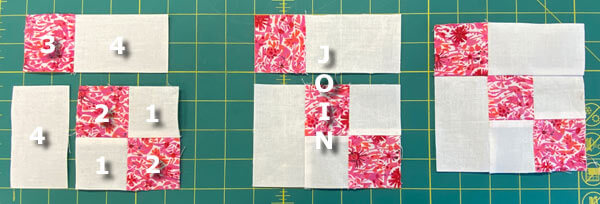
Here's an up-close look at the front and back of a Corner to see the results of our pressing.
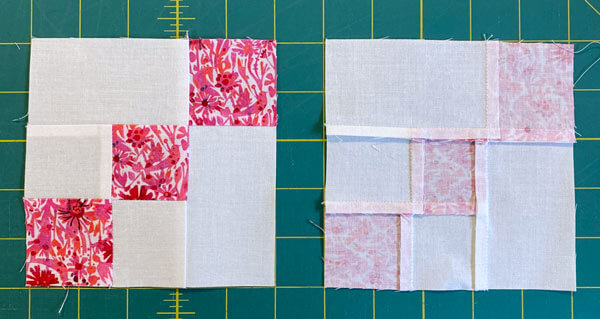
Refer to the chart to confirm the accuracy of your finished Corner. Our sample's Corner should be 5" square.
Repeat for all four corners.
Step 3: Assemble your Priscilla's Dream quilt block
Time to turn our dream into reality.
Arrange your patches so that your FGs point out from the center on the sides. The dark patches form a chain from the center to the outside corner. The cut square completes the center.
With RST, sew the units in each row together. The seam lines of the FG match those of the Corner units. If you followed the pressing instructions, all those SAs nest.
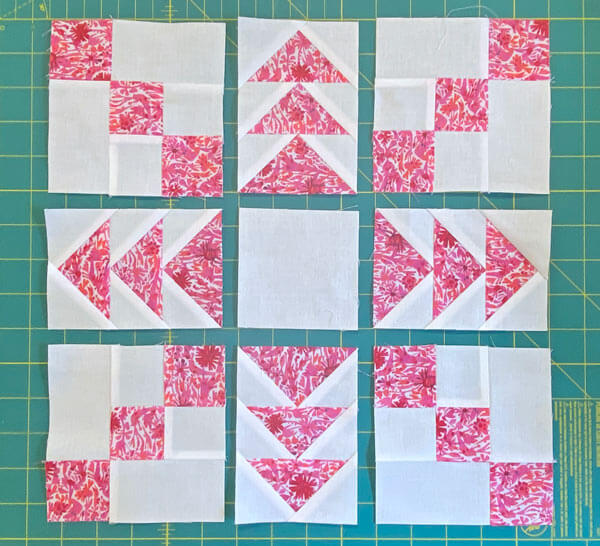 Sorry...for whatever reason this image is washed out a bit.
Sorry...for whatever reason this image is washed out a bit.The seams in these rows are all pressed away from the FG.
Stitch the rows together. Use your pins as you need them to hold edges even and points in place as you sew.
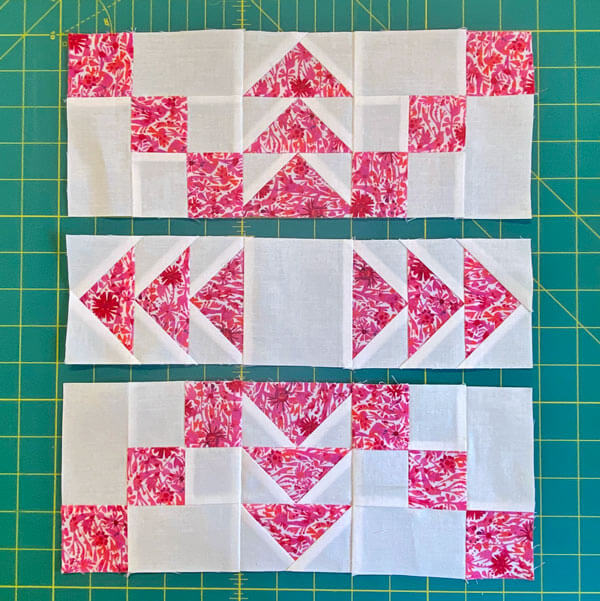
Our Priscilla's Dream quilt block is finished.
Paper piecing those FG Trios made block assembly a 'dream'. All the seams lined up and nested at exactly the right spot.
Having the patience to sew on a line makes so many tasks in quilting easier...foolproof in fact!
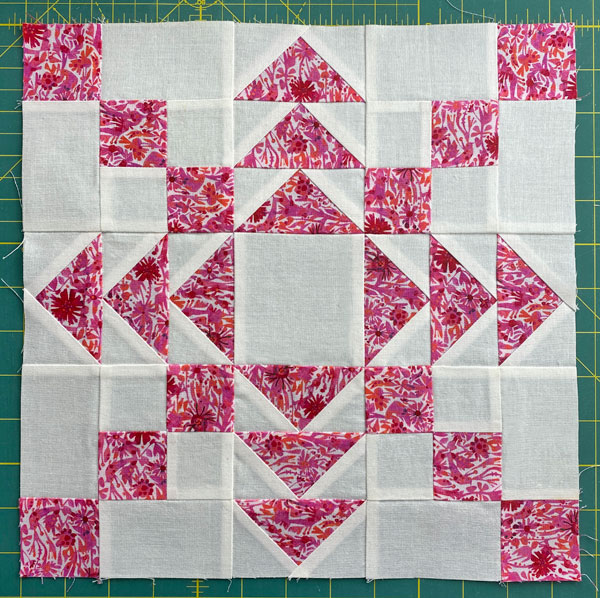
A final look-see from the backside.
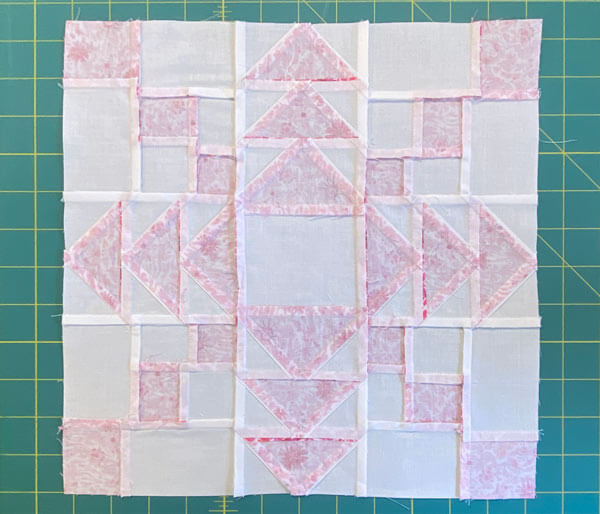
When I was learning to sew clothes as a kid, both my Mom and Grandma insisted (loudly) that the inside should look as good and the outside.
The same rule applies to my quilting today. ;)
What about a different quilt block?
For a list of all the 220+ quilt block patterns on this site, start here.
If you know the name of the block, shorten your search by using these links:
Click here if you're looking for blocks with at least some paper piecing.
Click here if you're looking for the basic building blocks of quilting, i.e., Flying Geese, half square triangles, quarter square triangles, etc., along with several techniques to make each.
And finally, use these links to find blocks in these finished sizes:
- Home
- Free Quilt Block Patterns
- Priscillas Dream Quilt Block
